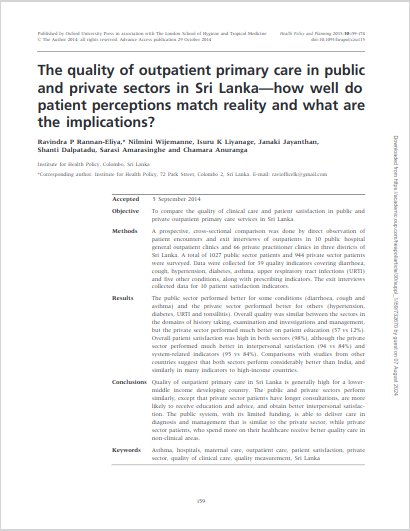Rannan-Eliya, R. P., Wijemanne, N., Liyanage, I. K., Jayanthan, J., Dalpatadu, S., Amarasinghe, S., & Anuranga, C. (2014). The quality of outpatient primary care in public and private sectors in Sri Lanka—how well do patient perceptions match reality and what are the implications? Health Policy and Planning, 30(suppl_1), i59–i74. https://doi.org/10.1093/heapol/czu115
Abstract
Objective
To compare the quality of clinical care and patient satisfaction in public and private outpatient primary care services in Sri Lanka.
Methods
A prospective, cross-sectional comparison was done by direct observation of patient encounters and exit interviews of outpatients in 10 public hospital general outpatient clinics and 66 private practitioner clinics in three districts of Sri Lanka. A total of 1027 public sector patients and 944 private sector patients were surveyed. Data were collected for 39 quality indicators covering diarrhoea, cough, hypertension, diabetes, asthma, upper respiratory tract infections (URTI) and five other conditions, along with prescribing indicators. The exit interviews collected data for 10 patient satisfaction indicators.
Results
The public sector performed better for some conditions (diarrhoea, cough and asthma) and the private sector performed better for others (hypertension, diabetes, URTI and tonsillitis). Overall quality was similar between the sectors in the domains of history taking, examination and investigations and management, but the private sector performed much better on patient education (57 vs 12%). Overall patient satisfaction was high in both sectors (98%), although the private sector performed much better in interpersonal satisfaction (94 vs 84%) and system-related indicators (95 vs 84%). Comparisons with studies from other countries suggest that both sectors perform considerably better than India, and similarly in many indicators to high-income countries.
Conclusions
Quality of outpatient primary care in Sri Lanka is generally high for a lower-middle income developing country. The public and private sectors perform similarly, except that private sector patients have longer consultations, are more likely to receive education and advice, and obtain better interpersonal satisfaction. The public system, with its limited funding, is able to deliver care in diagnosis and management that is similar to the private sector, while private sector patients, who spend more on their healthcare receive better quality care in non-clinical areas.

